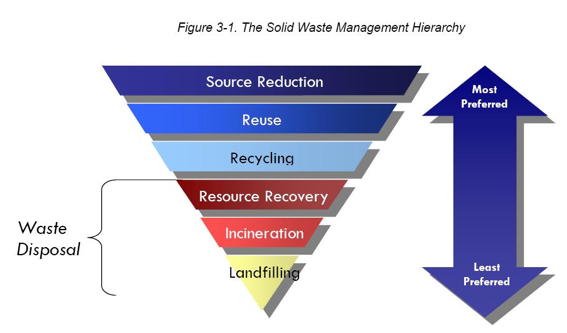Most likely you’ve heard about the three R’s; reduce, reuse, recycle. As children, this concept is drilled into our heads, yet as adults, these simple guidelines seem to go right out the window. Waste management is a serious issue in the United States. The EPA estimates that each year, we dispose of 232 million tons of trash, much of which can be avoided entirely.
Below is a graph displaying a solid waste management hierarchy. Source Reduction is the most preferred tier, followed by reuse, recycling, and finally incineration and the landfill. Often people focus on the recycling tier, forgetting that reuse and ultimately source reduction are where we should direct our attention.
Individuals who lived through the Great Depression understand the concept of reduction and reuse all too well. As our nation has become more affluent, our waste per capita has increased exponentially. This is due, in part, to the influx of single-use, disposable products. The other side of this coin is simply that we can afford to waste. Over time, our behavior and social systems have changed to match these trends.
A classic example of this shift is the demise of the reusable milk jug. Not so long in the past, milk was delivered to the home daily in a reusable bottle. The used bottles were collected, sanitized, and filled again. This process of reuse was a part of daily life.
Social systems are a moving target. Change is a constant, yet we are the creators of the systems and therefore, have the ability to control the direction. Just as we can steer away from reusable milk jugs, we can shift the other way and adopt new systems to combat our waste issues.
The Eco-Takeouts™ provide a great example of a reusable system that fits within the framework of modern life. These reusable containers operate in a closed loop system. Through either automation or exchange tokens, Eco-Takeouts™ can be checked out of the dining environment and then returned later for sanitization and refilling. This process of reuse not only keeps waste out of the landfills, but also reduces the total amount of resources used to produce single use containers.
As we continue to pursue sustainability concepts, we should remind ourselves that source reduction and reuse are where the maximum benefits can be obtained. Although we can engineer all sorts of solutions to manage our waste and environmental problems, the easier path is to change our behavior and design systems that promote sustainability.

